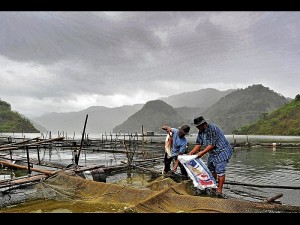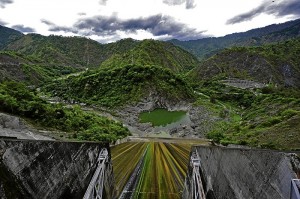Benguet village discovers new economy as hydro dam is reborn

BOATS now line Ambuklao dam because people plan to make a visit to this historic facility, now a tourist attraction. PHOTO BY EV ESPIRITU/INQUIRER NORTHERN LUZON
BOKOD, Benguet – Robert Bongsiw of Barangay (village) Ambuklao here has a job as fisherman that his Ibaloi elders would never have tried in upland Benguet.
At dawn each day, Bongsiw would harvest crimson snapper (maya-maya) tilapia and silver carp from fish cages in the Ambuklao Dam. He would string these fish together using straw or skewer these on a bamboo stick to be sold for P110 a kilogram at the Baguio City market.
There are 83 other fish cage operators who have been making the Ambuklao Dam their source of livelihood since 1994.
Younger Ibaloi have taken a liking to this skill they call “manikay” (fishing) since the old Ibaloi and Iowak communities and their rice fields here were submerged in 1950 when government built the Ambuklao dam and hydroelectric power plant.
The dam used to be a leading generator of electricity when it went online in 1956, but the facility had been decommissioned in 1999 due to damage incurred from the 1990 Luzon earthquake.
On June 1, however, Ambuklao’s new owner, SN Aboitiz Power (Snap), reopened the dam after upgrading its system to a degree that enabled the firm to increase the dam’s capacity from 75 megawatts (MW) to 105 MW.
The upgrade has given the 60-year-old dam a new 25-year lease on life, says Michael Hosillos, Snap vice president for communications.

AMBUKLAO dam, the biggest hydroplant of its time in the 1950s, has been decommissioned in 1999. In June, new owner SN Aboitiz Power recommissioned the dam, giving it another 25-year lease on life. PHOTO BY EV ESPIRITU/INQUIRER NORTHERN LUZON
But the firm did not venture into the revival of Ambuklao, and the upgrade of neighboring Binga Dam in Itogon town, without looking at the welfare of residents in the villages of Ambuklao and Binga, Hosillos says.
Both villages now have their Ibaloi heritage and cultural sites, he says.
The 2009 report of the United States-based Compliance Advisor/Ombudsman (CAO) says the heritage sites allow the Ibaloi to assume management of their village, “creating immense possibilities for the site use such as eco-tourism, livelihood, cultural programs, and socialization.”
The CAO is an accountability mechanism set up by the International Finance Corp. and the Multilateral Investment Guarantee Agency (Miga), which was approached by Ibaloi clans seeking redress over their ejection because of the dams’ construction.
The CAO report says while local courts legitimized the expropriation process that allowed government to build the Ambuklao and Binga dams, former President Fidel V. Ramos authorized the National Power Corp. to extend more benefits to the Ibaloi and Iowak communities in 1997.
“This dialogue resulted in a shift from an emphasis on land ownership to the use or meaning of land. The change is significant because the people tied to the land their identity, opportunity and security,” the report states.

BARANGAY AMBUKLAO residents have learned to swim, and then to fish, in this mountain-locked community, ever since their ancestors were displaced by the giant dam in the 1950s. Government has allowed them to keep fish cages there where residents grow tilapia and carp. PHOTO BY EV ESPIRITU/INQUIRER NORTHERN LUZON
This sense of identity could explain why younger Ibaloi in Ambuklao learned to swim and fish, Bongsiw says, adding that their lives now revolve around the dam’s waters.
Pino Waking, senior provincial agriculturist of Benguet, says the dam started out as 700 hectares full of water, but 60 years of siltation reduced the size to 400 hectares.
But the reservoir water has zero salinity, which has given better flavor to fish grown there, Waking says.
Bongsiw says they supply 30 vendors in Baguio with as much as 1,000 kg of fish every day.
Ambuklao fish is virtually a brand because of an increasing demand, he says.
But fishermen in Barangay Ambuklao won’t get rich from fishing because they are restricted by the Bureau of Fisheries and Aquatic Resources to 6.8 hectares of fish cages, which can accommodate only 10 fish for every cubic meter of water.
McConnell Dowell Philippines, which Snap had contracted to oversee the rehabilitation of the Ambuklao and Binga plants, have been introducing employment ideas to Barangay Ambuklao residents.
In May, the firm provided training in manufacturing charcoal briquettes, using pine needles, driftwood and other forest wastes that end up floating in the reservoir.
The training was led by Rina Jularbal, owner of DRJ Group of Companies, which manufactures briquette-making machinery. It has benefited former employees of the power plant.
The program also helps clean up the reservoir, which Barangay Ambuklao plans to develop into a tourist attraction, complete with boat tours.
“It’s best if we use pine needles to convert into charcoal because of the natural oil that the leaves contain. You may also use discarded cabbage but you would probably appreciate me better if I teach you how to convert that into kimchi,” Jularbal says. With a report from EV Espiritu, Inquirer Northern Luzon